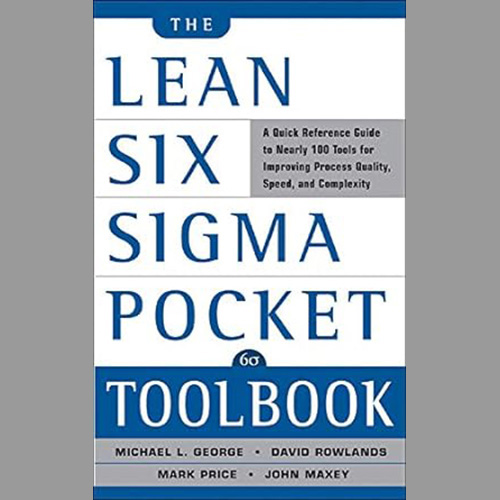
What are QUICK TAKES?
Like many of you, we like to read. These are some of our favorite books. We jotted down some highlights, and we asked our AI team member to organize our thoughts. The name "book summary" is a stretch, so we named this work QUICK TAKES. Definitely some good reads on the list. There is a wide variety of general business books, LEAN books including some classics, as well as books on the power of story telling. Enjoy!
Lean SIx Sigma Pocket Toolbook by Michael L. George
Introduction
"The Lean Six Sigma Pocket Toolbook" by Michael L. George, along with co-authors David Rowlands, Mark Price, and John Maxey, serves as an essential guide for anyone involved in the process improvement space. This book distills complex methodologies into a concise and practical format, making the powerful tools of Lean Six Sigma accessible and applicable. This report delves into the key concepts, tools, and applications presented in the book, offering a straightforward analysis of its content and utility.
Book Summary
The book is structured as a comprehensive reference guide, categorizing tools into major sections that align with the different phases of the Lean Six Sigma process: Define, Measure, Analyze, Improve, and Control (DMAIC). Each section is dedicated to a specific phase, providing a suite of tools that are most applicable at that stage.
-
Define Phase: This section focuses on tools that help in defining the problem and scope of the project. Tools like the Project Charter, Voice of the Customer (VOC), and Critical To Quality (CTQ) trees are explained with step-by-step instructions on how to use them to set clear goals and understand customer needs.
-
Measure Phase: In this part, the book covers tools that assist in measuring current performance and identifying data sources. It includes methods for data collection, ensuring data accuracy, and establishing baselines. Tools such as Statistical Process Control (SPC), Process Mapping, and Measurement System Analysis (MSA) are highlighted.
-
Analyze Phase: The Analyze phase tools are designed to help identify the root causes of problems. The book details analytical tools like Cause and Effect Diagrams, Failure Mode and Effects Analysis (FMEA), and Hypothesis Testing, guiding readers on how to analyze data and identify significant factors affecting the process.
-
Improve Phase: Here, the focus shifts to tools that aid in developing and testing solutions to eliminate root causes of defects. Tools such as Design of Experiments (DOE), Mistake Proofing, and Process Simulation are discussed, offering insights into how to make impactful changes in processes.
-
Control Phase: The final section emphasizes tools that ensure the sustainability of improvements. Control charts, Standard Work, and Visual Management are among the tools presented to help maintain the gains achieved through the earlier phases.
Each tool is presented with a clear description, instructions for its use, and examples or case studies where applicable. The book's layout is designed for quick reference, allowing practitioners to easily find and apply tools in their day-to-day work.
Core Themes and Analysis
The central theme of the book is the practical application of Lean Six Sigma tools to improve quality and speed in any process or organization. The authors emphasize the importance of a systematic approach to problem-solving and continuous improvement, advocating for data-driven decision-making and cross-functional collaboration.
One of the book's strengths is its pragmatic approach. Instead of delving into theoretical discussions, it focuses on the "how-to" aspect of each tool, making it incredibly useful for practitioners who need to apply these concepts in real-world settings.
The book also highlights the synergistic relationship between Lean and Six Sigma methodologies, demonstrating how they complement each other to enhance process efficiency and effectiveness. Lean principles focus on eliminating waste and speeding up processes, while Six Sigma aims at reducing variation and improving quality. Together, they provide a comprehensive framework for operational excellence.
Implications and Reflections
"The Lean Six Sigma Pocket Toolbook" is more than just a collection of tools; it's a testament to the value of structured problem-solving and continuous improvement in today's competitive business environment. It underscores the need for organizations to adopt a culture of excellence and provides a roadmap for achieving it.
One of the key takeaways is the democratization of quality improvement methodologies. By distilling Lean Six Sigma into a pocket toolbook, the authors make these powerful tools accessible to a broader audience, not just quality professionals or upper management.
However, while the book excels in providing practical guidance, it's important to note that the successful application of these tools requires more than just technical know-how. Organizational culture, leadership support, and team dynamics play crucial roles in the effective implementation of Lean Six Sigma projects.
Conclusion
"The Lean Six Sigma Pocket Toolbook" is an invaluable resource for anyone involved in process improvement, from novices to seasoned practitioners. It simplifies complex methodologies into practical tools that can be readily applied to enhance quality, increase speed, and reduce costs.
The book's straightforward style, structured layout, and focus on practical application make it an essential guide for implementing Lean Six Sigma principles. It not only serves as a quick reference tool but also as a catalyst for organizational transformation, encouraging a proactive approach to problem-solving and continuous improvement.
In sum, this toolbook is not just about the tools of Lean Six Sigma; it's about fostering a mindset of excellence and providing the means to achieve it. It's a guide that empowers individuals and organizations to take control of their processes and outcomes, driving them toward higher efficiency and effectiveness in their operations.
